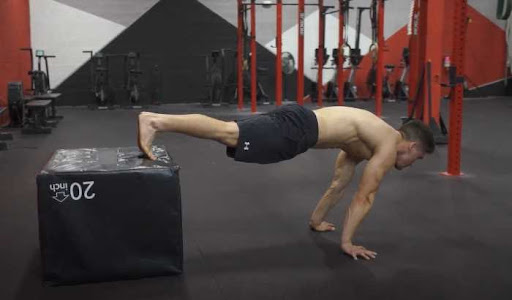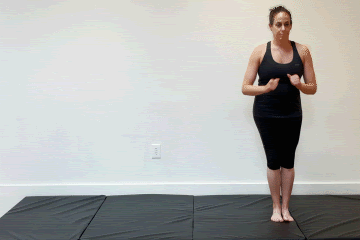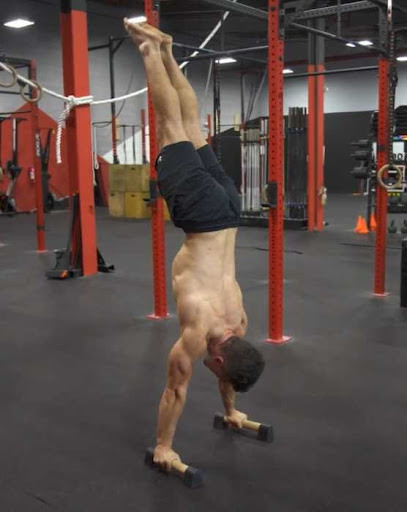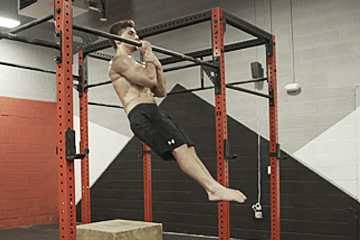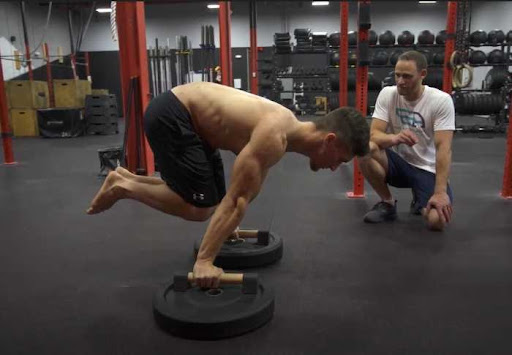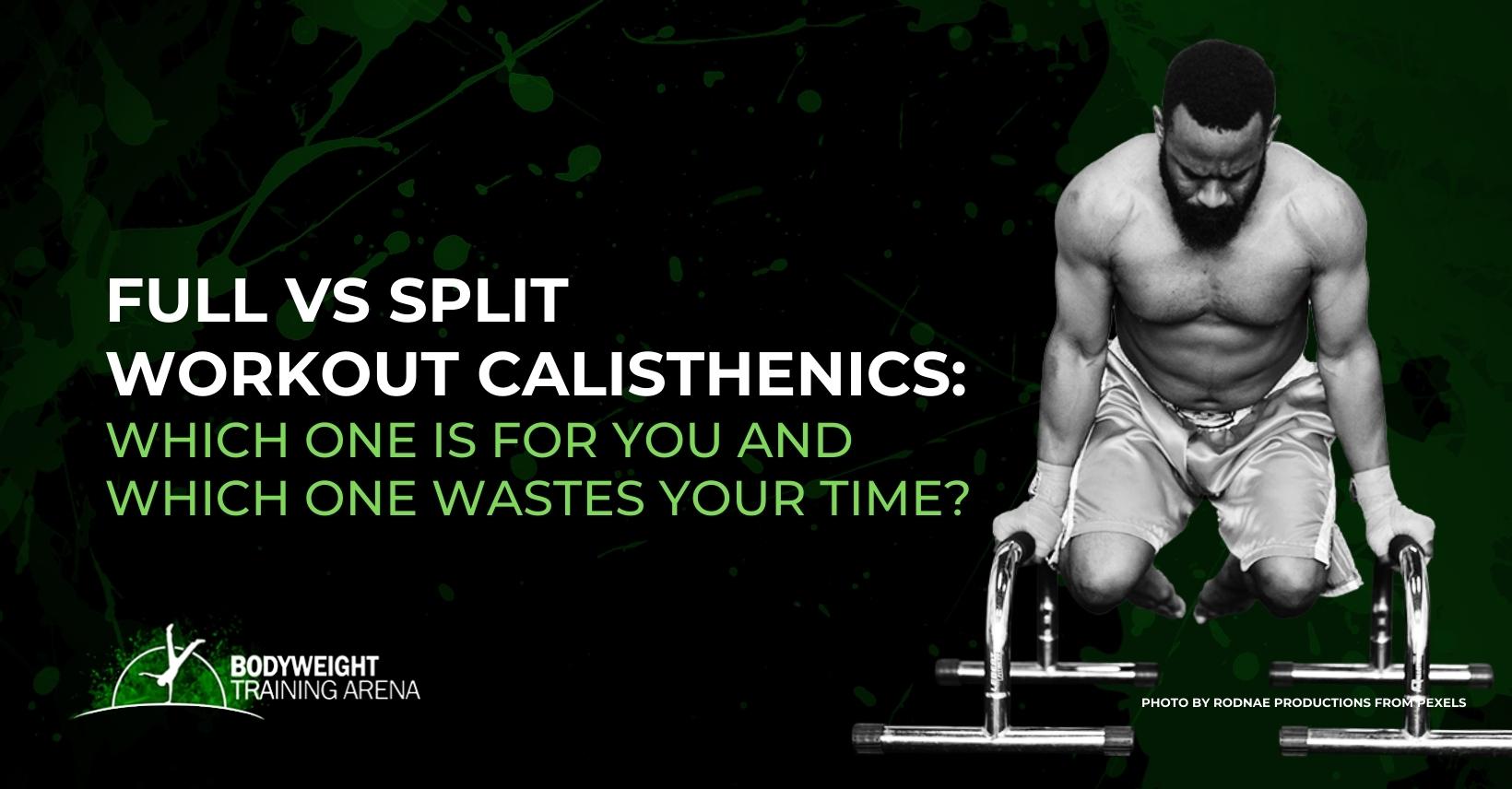
Join the tribe of Movement & Calisthenics Athlete – People just like you that are working with their own body weight to get strength, lose fat build muscle, recover from injuries and live their best lives!
Calisthenics is one of the most popular workouts in the world. It’s a great way to build strength and muscle without having to spend money on weights or other equipment.
The best type of training for calisthenics depends on what you are trying to accomplish. Full body, split, or skill training can all be useful depending on your goals.
Full body workout vs split routines is a very common dilemma in the fitness industry, not just in the calisthenics community.
Which one is the best for you?
In this article, we will go over each type of training structure and explain how they can help you reach your fitness goals!
Full body training
Let’s first clarify what’s a full-body workout. It’s a type of workout program structure that involves the full body in one workout. It’s not just multiple muscle groups, it covers all the body parts in a span of multiple compound exercises.
Due to the high demand, this training style applies to your body, training days are usually limited to 2-4 times per week. Anything more can be excessive and hurt your strength gains and muscle growth.
Advantages
Balanced development
Full body program trains the whole body for each workout which allows all the major muscle groups to get trained equally. It helps develop a balanced body as long as the workout plans are structured with exercises hitting every muscle group.
Full-body workouts minimize the risk of favoring a specific body part as much as possible since you hit the same muscles every workout. It’s also perfect for gaining functional strength because you train your full body like how you use your body in the real world, using multiple muscle groups to perform a movement, rather than isolating certain muscle groups.
Missing a workout is easier
When you miss a session of a full-body routine, you have other days of the week to hit the same muscle groups with the same workout. Full-body routines are usually done at least three times per week. Miss one then you’ll still have two more sessions to make it up.
Unlike working with a split routine in which if you miss a single session of a particular body part, you might have to adjust the whole schedule or you will leave that body part lagging compared to the other body parts.
Higher calories burnt for fat loss
You can easily implement HIIT exercises or cardio exercises for more fat loss.
Full-body training hits the full-body (as if we haven’t said this yet). Using multiple muscle groups per session burn calories more than training for only a certain muscle group. Your body requires more effort to train the whole body which increases your total energy expenditure which is perfect for fat loss.
You can also develop muscle mass at the same time given that the calorie burn the whole day is slightly more than what you consume, you get a sufficient amount of protein, and get an ample amount of high-quality rest.
Less training frequency
Recovery time is a crucial factor for building muscle, strength and developing skills. Full-body workouts give you the luxury of setting fewer training sessions per week to allow your body to recover in between sessions. This means more time for other responsibilities in your life as well!
Disadvantages
Difficult to train skills
Handstand is the easiest calisthenics skill you can implement in full-body workouts given you use the proper progression in your structure.
Calisthenics skills demand a high level of strength, mental focus, and other aspects which is why it’s best to train them specifically per session.
Especially for strength-based skills such as planche, it’s better to integrate a split routine that’s dedicated to the skill. A good example for planche is a planche-pull-lower body split.
When training skills, perfect form and good technique are a must. But when training the whole body in a session, there are too many elements that can interfere with your skill development.
An advanced trainee can get away with full-body workouts while including skills, but this requires a longer and better recovery process.
You can also include low-intensity skill exercises to a full-body workout if your skill level allows you to. If you already have a good strong foundation of pull-ups, dips, and push-ups, adding handstands to a full body session can be possible.
Easy to underestimate
At first look, full-body workouts seem easy to do especially with only 2-3 sessions per week, but once you get to training, you’ll realize how difficult it is and how easy you can overtrain if you’re not listening to your body.
If you want to train more than three times per week with full-body workouts, it’s best to lessen the intensity of your workout and play with different movements, and combinations per session. Doing the same workout with the same high intensity is an easy recipe for overtraining. And overtraining is very damaging to your progress and mental focus.
Intensity can be mismanaged
There are different ways to train your full body in a workout. Exercises and structures can vary which can affect the intensity of the whole workout.
Who can focus on full-body routines
Beginners or individuals from a training hiatus – Full body workouts are the best training structure beginners can start with. Beginners can first get used to the different movement patterns while still developing strength and muscle. It’s best to stick with the fundamental exercises such as dips, push-ups, pull-ups, and squats of the easier progressions. This training style also keeps the training frequency pretty low as beginners are still developing their capacity to train more in a week.
Holistic strength development – Balanced strength gains for multiple muscle groups are the major for a full-body workout. How to use the full-body when executing these strength movements teaches you to move your body as a whole.
Build muscle and lose fat – If you want to get in better shape, full-body calisthenics keeps the intensity high as you burn more calories and build up muscle.
Less training time – Not everyone has the time in the world to commit to a split training. Sometimes, we can only afford to give 3 hours for our strength gains but that’s already enough.
Split training
Advanced calisthenics skills such as the one-arm pull are best done on a split-type workout.
Split routines are splitting your workout per muscle group or per movement pattern so that you don’t train the whole body in one workout.
Each training session is spread out so that the trained muscle group can rest while you work on other muscle groups. Each muscle is usually trained 1 to 2 times per week but with a higher volume in a given session.
Split workouts can be split per body, per muscle group, or per movement pattern and skill.
Advantages
Excellent for bodybuilding
You can provide extra attention to the muscle group you want to develop and gain a good amount of volume for muscle gains. Split workouts are a common bodybuilding approach that gives huge success for this goal.
Even if you’re working with calisthenics, you can still split your workout and work on one muscle at a time since there are various exercises to help you do so. For example, if you want to work on your biceps, you can first do chin-ups, then move to bodyweight bicep curls to add extra volume to that single muscle.
More versatile
Training splits offer versatility in what you want to achieve since you can modify your structure depending on your goals. If you want to build overall muscle, you can train with a push-pull-legs split. You can also train with an upper-body focus routine for supreme upper body development. There are many exercise combinations and split workouts you can play around especially because the energy expenditure is relatively less since you are working on fewer body parts per session.
Can focus on specificity
With split training, you can implement more exercises that are geared towards a specific goal rather than training with a generalist approach.
If you want to learn skills, then split can provide a great avenue to lock on target-specific weaknesses in your skill development.
With split training workouts, you can use exercises that are heavily focused on the certain skill you are working on then use general exercises on a separate day.
Full-body workouts are too rigid and have too many exercises for you to work on your specific goal, especially on skills.
For example, planche demands a heavy demand on push work and planche-specific exercises. Doing too many movements that do not help you achieve the planche goal will slow down your progress.
Disadvantages
More workouts per week
Since you will be splitting your workout into more sessions, you will get more sessions per week. You can’t play around to minimize your session into four, but the average will be five to six training days. Spreading your workout sessions allows each of the single muscle to rest and keep the body part fresh for the succeeding session.
Potential imbalances
You’re more likely to favor one muscle group or body part when working with a body part split. It’s just a tendency that everyone experiences because we all have weaknesses and strengths. We tend to work more on our strengths and what we enjoy and less on our weaknesses. That being said, take the opportunity from split workouts to address any weak links in your body so you can grow stronger faster, as well as healthier.
Difficult to catch up after missing a workout
If you miss a single workout on a body part split, it’s more challenging to replace the session you have missed especially if you are training a muscle group once a week in your split routine. Committing to your schedule is best and minimize any missed days on your split workouts.
Who can focus on split routines
Intermediate to advanced athletes – Due to the high volume and high frequency of a split routine, this training approach is best reserved for more experienced calisthenics athletes. Beginners might have some difficulty recovering from splits especially with calisthenics exercises since most movements require the use of the full body.
Focus on getting bigger – As you mentioned earlier, if you want to build muscle, then split is the optimal approach. Ring training or even weighted calisthenics provides a solid option for more experienced athletes.
Want to train skills – If you already have mastered the calisthenics fundamentals and want to develop skills, getting a split workout is a huge thumbs up! Get more rest and get more specificity in your workout.
Fits the schedule – If your schedule can fit the split, then so be it! There are more workouts per week compared to full-body workouts so expect to get your body work almost every day. Scheduling is vital if you want to commit to split body workouts.
FULL BODY ROUTINE SAMPLE
Monday – Workout session: Exercises – Push-ups, Pull-ups, Dips, Bodyweight rows, Squats, Calf raises, Core+Mobility exercises
Tuesday – Rest
Wednesday – Workout session: Exercises – Push-ups, Pull-ups, Dips, Bodyweight rows, Glute-ham bridge, Quad extensions, Calf raises
Thursday – Rest
Friday – Workout session: Exercises – Push-ups, Pull-ups, Dips, Bodyweight rows, Squats, Calf raises, Core+Mobility exercises
Saturday – Rest
Sunday – Rest
SPLIT ROUTINE SAMPLE
Monday – Push day 1: Exercises – Dips, Archer push-ups, Chest ring flyes, Triceps push-ups
Tuesday – Legs: Exercises – Squats, Bodyweight quad extensions, Glute-ham bridge, Wall squats, Calf raises
Wednesday – Pull day 1: Exercises – Pull-ups, Bodyweight rows, Bodyweight bicep curls, Face pulls, Core exercises
Thursday – Rest
Friday – Push day 2: Exercises – Dips, Pike push-ups, Push-ups, Handstand shrugs, Tricep dips
Saturday – Pull day 2: Exercises – Chin-ups, Bodyweight bicep curls, Face pulls, Core exercises
Sunday – Rest
Conclusion
The full body vs split is a commonly debated topic in the fitness industry. Some people work best with full-body workouts, some people prefer body part split, some people do a combination of both!
At the end of the day, the full-body vs split comes down to what works for you and your preference.
Do what you enjoy and where you find success with. Each approach has its own list of advantages and disadvantages and this can be your guide on which training structure you will work on with your calisthenics journey.
Oftentimes, finding the right structure for you is difficult with too many variables that come into play. This is because the best calisthenics training structure and program is the one that is tailored and personalized to your current skill level, training goals, and personal lifestyle.
Finding the right training structure isn’t enough especially if the program is a one-size-fits-all or cookie-cutter type. Those programs actually do more harm and than good in the long run. You can read more on that topic in this article: Beginner/Intermediate/Advanced: Why this type of training is hurting your progress
The perfect calisthenics program is structured to what you want to achieve, what you need to achieve, and what you can do right now.
The first step is knowing where you are in your calisthenics journey so you can know how to work towards your training goals.
Here’s a short assessment below so you can get started working on your fitness. Remember, fitness is a life-long journey. There’s no need to rush it.
TAKE THE ASSESSMENT NOW!

